Why These Six Philippine Festivals is a ‘Must-Experience’
The Philippines is a tropical paradise with stunning beaches and landscapes that draw in tourists from all over the world. But more than its natural wonders, it is also a culturally diverse archipelago, where each island offers a unique experience. These experiences are best encapsulated in the local festivals that feature world-class performances and exhibitions.
All year round, the calendar is jam-packed with a myriad of vibrant festivals that celebrate the rich tapestry of Filipino heritage.
Often, these traditional festivals are a combination of local history, folklore, old dance rituals, religious practices, and playful imagination. The result is a joyful celebration on the streets where every visitor is part of the festivities.
Indeed, the festivals of the Philippines are not just events. They are immersive experiences that transcend borders and unite people from all walks of life.
Six of the best festivals in the Philippines you must experience
Among the seemingly endless celebrations and colorful festivals that dot the archipelago, some have grown into international prominence. Each year, these grand spectacles culminate in a burst of energy, music, and vivid hues, drawing locals and tourists alike into a whirlwind of celebrations.
From the renowned Sinulog Festival in Cebu to the well-loved Ati-Atihan Festival in Kalibo, the Philippines boasts famous festivals that beckon attendees to immerse themselves in the nation’s cultural heartbeat.
That said, here are six of the biggest festivals in the Philippines that you should not miss.
Sinulog Festival in Cebu
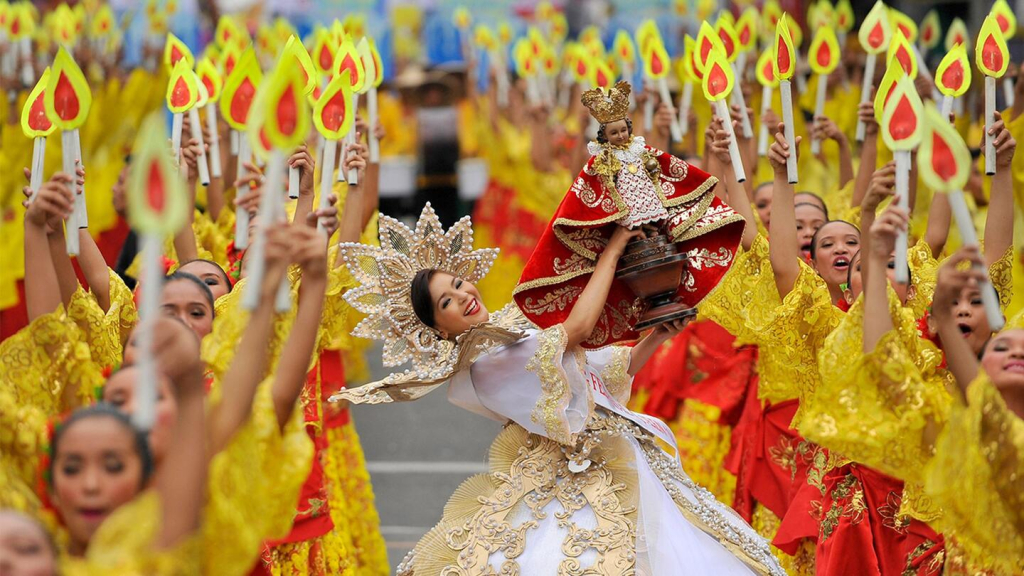
Among the festivals in the Philippines, the Sinulog in Cebu stands out as the one that draws in the most crowds each year. Often described as a dance extravaganza that pulsates with religious fervor, Sinulog is a grand celebration and annual religious festival that pays homage to the Sto. Niño, the Holy Child Jesus.
Though a holy celebration, Sinulog also features an exuberant street revelry. Here, participants dance in a trademark two-steps-forward, one-step-backward pattern, which mimics a river current or sulog, from where the famous festival itself is named after.
Drums in the tunes of traditional music lead the participants in Sinulog as its lively procession weaves through the streets of Cebu City. Along its path, bystanders and spectators often join in not only to celebrate but also to show their devotion to the Sto. Niño.
With its lively energy and cultural significance, the Sinulog Festival not only draws locals in deep reverence but also attracts tourists from around the world, making it a must-experience event that beautifully encapsulates the spirit of the Philippines.
Cebu City Date of Festival : Cebu City celebrates Sinulog every third Sunday of January. The celebration also includes weekly shows, fairs, and other activities throughout the month leading up to the grand event so more visitors can enjoy the long festival season.
Dinagyang Festival in Iloilo
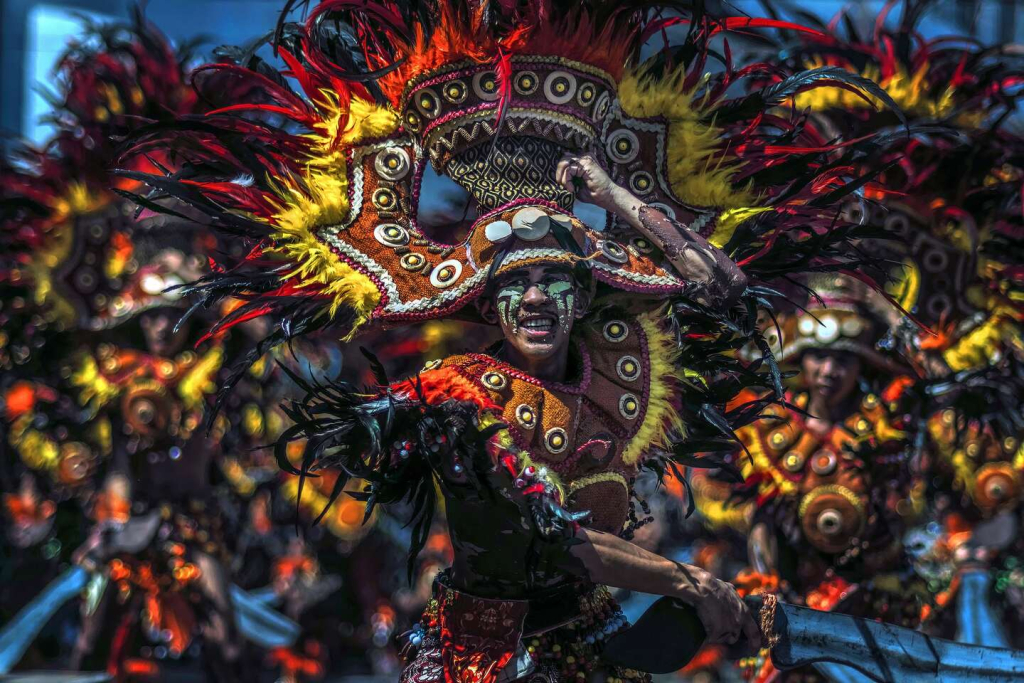
Next to Sinulog, Dinagyang is another gigantic festival in Visayas that draws in over a million people to Iloilo City each year. At its core, the celebration is all about dagyang, the Hiligaynon word for merrymaking, and like Sinulog, it honors the Sto. Niño.
However, Dinagyang differentiates itself with the Ati Tribe Competition, where participants perform traditional dances to retell different iterations of the history of Panay. More specifically dance and costume competition, they tell the story of the Malay settlers arriving on the island and its legendary barter from the Ati natives.
This rich history, coupled with the elaborate costumes and infectious tribal beats, made Dinagyang the most awarded festival in the country. Such success also earned its moniker as the “Queen of All Philippine Festivals.”
Incorporating cultural traditions and religious roots, the festival culminates in a religious procession, in a unique melding of indigenous pagan rituals and Catholic practices. The result is not only a captivating visual spectacle but also a profound cultural experience that immerses both locals and visitors in the rich heritage of Iloilo.
Iloilo City Date of Festival : Locals celebrate Dinagyang every fourth Sunday of January, with many events lined up all month long to make your heart truly beat in Iloilo City.
MassKara Festival
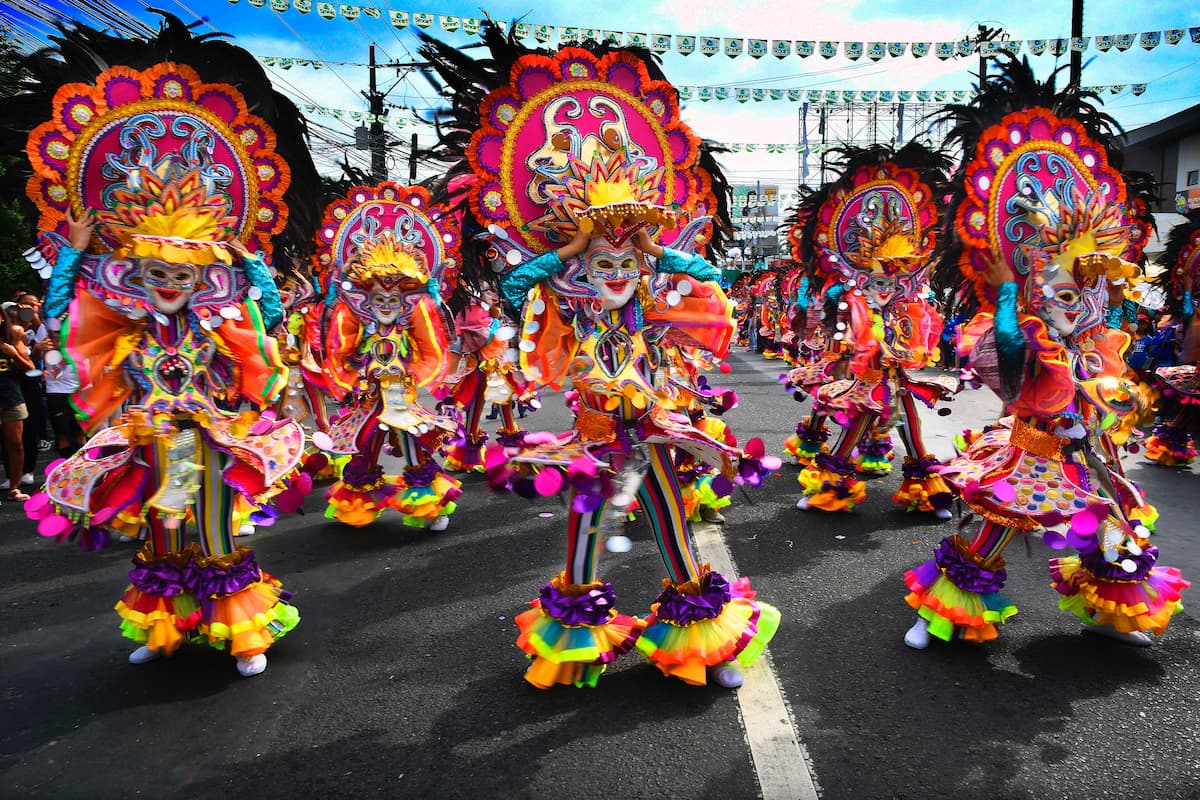
Unlike most festivals in the Philippines, MassKara Festival in Bacolod began as a celebration of resilience. Conceived during a turbulent time in the province, it served as a beacon of hope to locals who were facing an economic downturn and tragedy.
From this rose MassKara, a “festival of smiles” and a persistent commitment to live up to Bacolod’s moniker as the City of Smiles. Eventually, the festival indeed opened new doors for the city as it sparked growth in the city’s tourism, culinary, and arts and crafts industries.
MassKara could mean both a mask or a multitude of faces, and these elements are the highlight of its main event––the street dance competition. With lively music and costumed, dancing people in perpetually smiling masks, participants brighten up the streets of Bacolod in their wake.
Offering a more modern touch to traditional Philippine festivals, Bacolod City also added an Electric MassKara that lit up the city streets during the night with colorful LED lights.
Beyond the revelry, the festival also features beauty pageants, concerts, and a grand parade, creating an all-encompassing celebration of the city’s creativity.
With its festive atmosphere, vibrant costumes and artistic flair, the Masskara Festival has rightfully earned its place as one of the Philippines’ most visually stunning and emotionally resonant cultural celebrations.
Panagbenga Festival in Baguio
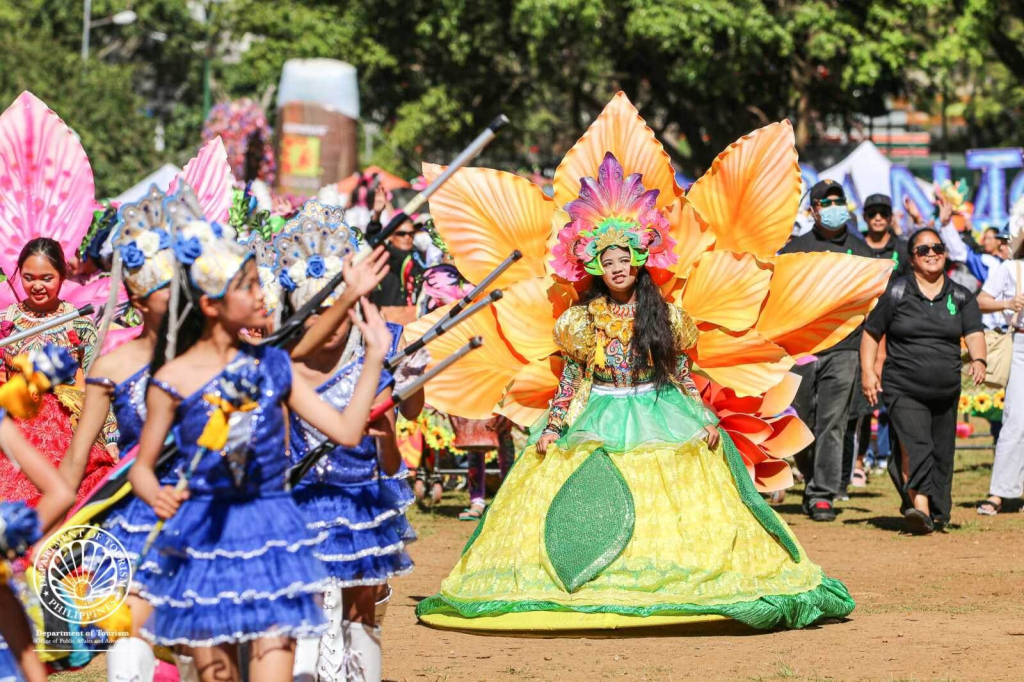
While other big Philippine festivals showcase their colorful culture and history, Baguio City parades its best blooms every year during the Panagbenga Festival. Like the MassKara festival, Panagbenga also rose from the rubbles of devastation in the wake of an earthquake that rocked Luzon in the 1990s.
Initially called the Baguio Flower Festival, the event’s highlight is a grand float parade of flower decks designed to represent objects or sceneries.
The resulting image is akin to that of the Rose Parade in California. Eventually, this showcase earned the festival the name it is known now––Panagbenga or “season of blooming” in the local Kankanaey.
Aside from the float parade, Panabenga’s month-long celebration also features a landscape competition, trade fairs, cultural shows, and street dancing from flower-clad participants moving to the beat inspired by an Ibaloi dance from the Cordilleras.
Overall, the festival not only celebrates the beauty of flowers but also emphasizes environmental awareness and the importance of preserving Baguio’s natural splendor.
Baguio City Date of Festival : Panagbenga is a month-long celebration in Baguio City that usually starts on the first day of February.
Ati-Atihan Festival in Aklan
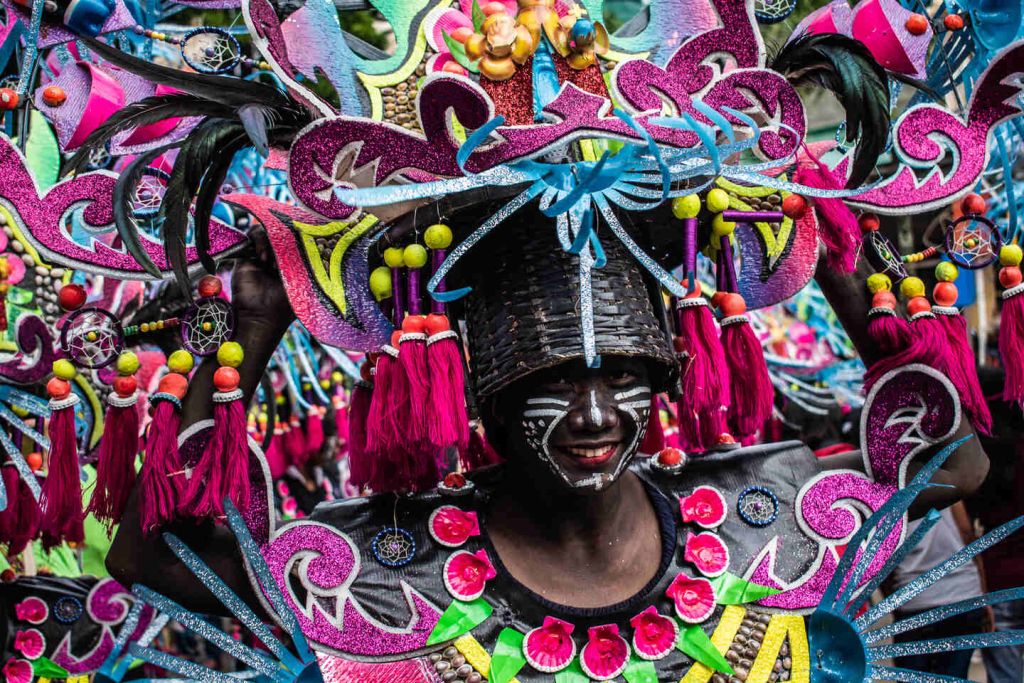
Before there was Dinagyang or Sinulog, there was only the Ati-Atihan Festival. Often referred to as the “Mother of all Philippine Festivals,” Aklan’s Ati-Atihan is cited as the inspiration for its similar festivals in Cebu and Iloilo.
Rooted in both religious and cultural traditions, this festival is an homage to the Sto. Niño and a commemoration of local legends and a celebration of its indigenous people.
Ati-Atihan is primarily a celebration to honor the Sto. Niño, but it is also a captivating display of indigenous dance and elaborate costumes. As such, the main festival day often begins with a mass that transitions into a parade (locally called Sadsad) along the streets.
What distinguishes Ati-Atihan is the unique and captivating dance performed by participants known as “Ati,” who paint their bodies in dark hues. On top of this, they also don indigenous costumes and dance vigorously to the rhythmic beat of drums and other traditional instruments.
Ati-Atihan’s lively and inclusive spirit has made it one of the most renowned and beloved festivals in the Philippines. Given this, it draws a large crowd of locals and international visitors into the heart of Aklan’s rich cultural heritage every year.
Aklan celebrates the Ati-Atihan Festival every third week of January, specifically on the third Sunday.
Capiztahan in Capiz
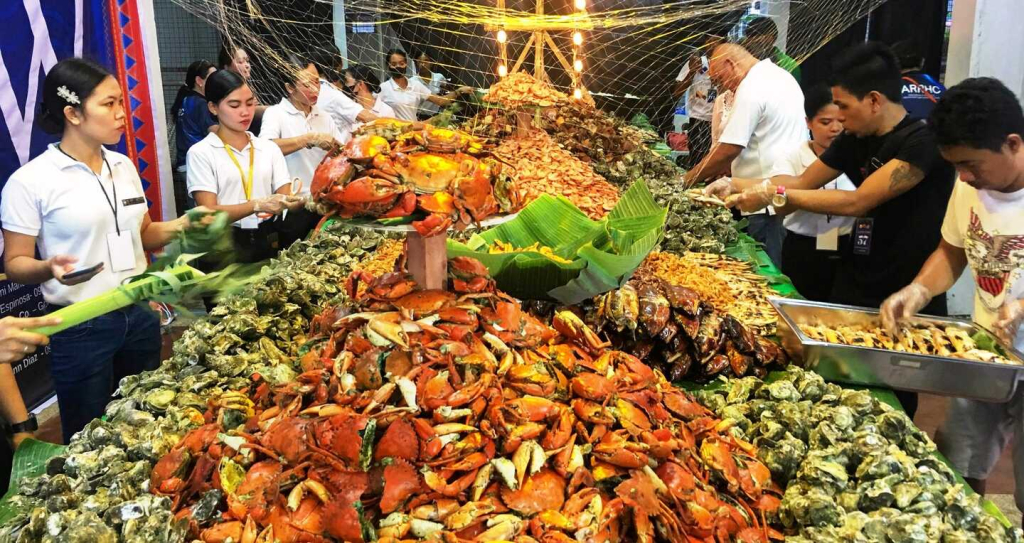
Drifting from the usual tribute to Sto. Niño and Ati dance competitions, the Capiztahan in Capiz put its produce at the center stage of its celebrations. Dubbed the “Seafood Capital of the Philippines,” Capiz takes pride in its abundant crabs, prawns, mussels, and milkfish.
During the festival season, visitors can often enjoy these selections for free. Aside from the food festival, Capiztahan also features a colorful array of events, including street parades and cultural presentations.
Though its most notable element is its seafood offering, the beginnings of Capiztahan is rooted in its founding anniversary and the commemoration of its late patriarch and former Philippine president, Manuel A. Roxas. Over time, the festival had grown into a lively event that opened the stage for Capiz to show its cultural heritage and unique traditions.
Locals and tourists alike flock to the province each year to enjoy this unique blend of cultural treats while savoring the freshest and most delectable seafood offerings. Ultimately, Capiztahan is not only a time of joyous revelry but also a reflection of the province’s pride in its cultural identity and natural bounty.
Capiz usually celebrates the festival during the month of April, with most of the activities held in its capital, Roxas City.
Other notable Philippine festivals
If you plot your calendar to attend a Philippine festival for the entire year, you will most likely find a celebration to look forward to every month. Here are other notable festivals in the country that are worth experiencing:
Higantes Festival
Location: Rizal
Purpose: Honors the town’s patron saint with a grand procession featuring enormous papier-mâché figures known as “higantes.”
Moriones Festival
Timing: Holy Week (usually in March or April)
Location: Marinduque
Highlight: Participants don colorful Roman centurion costumes, reenacting the story of Longinus during the crucifixion of Jesus Christ.
Giant Lantern Festival
Location: San Fernando, Pampanga (Christmas Capital of the Philippines)
Feature: Showcases intricately designed giant lanterns illuminated with colorful lights, attracting visitors during the Christmas season.
Pahiyas Festival
Location: Quezon
Theme: An elaborate thanksgiving festival where houses are adorned with colorful kiping (decorative rice wafer) and agricultural products.
Kadayawan Festival
Location: Davao City
Purpose: Celebrate the bountiful harvest and the diverse indigenous cultures of Davao through street dances, floral floats, and cultural exhibits.
Pintados Festival
Location: Tacloban City, Leyte
Tradition: Features body-painted dancers showcasing the ancient practice of tattooing, symbolizing bravery and beauty among the indigenous people of the region.
Celebrate uniquely Filipino traditions all year round.
Celebrating beloved traditions is sweeter in a truly Filipino community. Find your home in one of Camella’s neighborhoods across the Philippines.

Celebrate Life’s Milestones in Camella!
Make unforgettable memories in a Camella home.
Our communities are designed to elevate your living experience.


